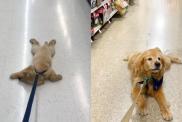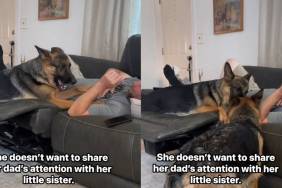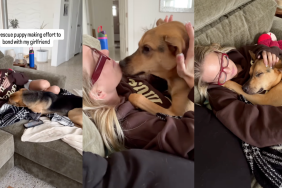These are three very useful commands which may be conveniently taught during your dog’s dinner time. By hand-feeding the initial portion of your puppy’s supper, it learns to take the food gently, and it may be taught the instructions ” Off!” and “Take it!.” “Off!” means don’t touch the food unless told to “Take it!” Initially, the pup is trained that it will always eventually be allowed to take the food, so long as it doesn’t touch for progressively increasing time intervals. By far, the best approach is to praise the cessation or absence of contact.
How to teach your dog ‘off’ and ‘take it’
Give your pup a couple of pieces of kibble, then hold a third piece firmly between thumb and fingers. Let the pup sniff and lick, but say “Rover, Off.” Allow the puppy to worry at the food treat in your hand for as long as it likes; eventually it will give up and withdraw its muzzle. The instant your pup breaks contact with your hand, say “Rover, take it” and offer the kibble by letting it fall into the palm of the hand, i.e., the pup has been rewarded for ceasing contact. Repeat this a couple of times. Next time, try for just a fraction of a second of non-contact before offering the food. Then delay offering the food for a full second after the pup breaks contact. On the next trial go for two seconds of non-contact. Praise your pup all the time it does not lick or paw, “Good dog, one; good dog, two” and then say “Rover, take it!” Now try for three seconds, then five and then eight and so forth. The pup develops confidence once it realizes “Off” does not mean it cannot touch the food at all, but if it waits for the “Take it” command, not only will it get the kibble but also plentiful praise and maybe even an additional tasty food treat into the bargain.
As soon as your pup learns not to touch the food for only a couple of seconds, you will proceed in leaps and bounds. The secret is to start with extremely short time periods, so that the puppy can succeed early on in training. If your pup noses or paws at the food during the forbidden time period, simply repeat the “Off!” request, and start the count from zero again. Your pup will learn that the quickest way to get the treat is by not touching it at all.
If ever the pup lunges or grabs, hold on tight to the kibble, loudly say “OUCH!,” repeat “OFF!” in an injured but nonetheless authoritarian tone and start the count from zero once more. On no account, let the puppy get the food. Do not let the pup take the food roughly. There is no need to physically punish or even loudly reprimand the pup. It is only necessary to let your pup know it hurt you. But it is essential to let your pup know it hurt you. This time say “Gennnntly” in a soft, prolonged manner before telling the pup to take it. If the puppy ever nips or hurts you, hand feed its entire meal. You must resolve the problem right away. If you think it’s bad now, wait until the pup becomes an adolescent.
How to teach your dog ‘thank you’
To teach “Thank you,” use an object of moderate value to the pup – a stick, a chewtoy or an old dry bone. When your puppy is chewing on its bone, say “Thank you,” with an extremely tasty treat in one hand, take hold of the bone with the other hand, say “Take it” and offer the treat. Once the pup has eaten the treat, say “Off,” proffer the bone and after a few seconds, tell the dog to “Take it.” Repeat this several times before trying it with more valued objects, such as a juicy bone, the dog’s food bowl or a paper tissue.
With the above exercises, dogs quickly develop confidence regarding human proximity around their valued objects. In fact, most dogs think this exercise is great. To indulge a little anthropomorphic license, perhaps they interpret “Thank you” to mean that the owner wants to hold their boring old bone and keep it safe, while the dog gets to munch on an extremely tasty treat.
“Off,” “Take it,” “Gently” and “Thank you” have numerous valuable applications. “Take it” encourages a fearful dog to take a food treat or toy from a stranger. “Gently!” instructs the dog how to take food from an unfamiliar child and how to play with the cat or a shy dog. Also, the “Off-Take it-Thank you” triad is a wonderful primer for later retrieval work.
On occasions, you may use “Off” to instruct the dog “Don’t touch, period!” i.e., you say “Off” but do not then say “Take it.” “Off” is useful to instruct a dog not to touch: the baby’s diapers, the baby, the neighbor’s bunny rabbit, a dead crow, fecal deposits of unknown denomination, a rattlesnake, a fearful dog or a large aggressive dog. It also warns a potential fighter not to touch the other dog.
You may use “Thank you” to expropriate articles already in the dog’s possession, such as a box of tissues, a computer disk or the Sunday joint of meat. Say “Thank you,” praise the dog and then instruct it to fetch a suitable chewtoy.
“Off” may be incorporated when using food lures in training to prevent the dog from slobbering over your mitts. For example, waggling a food treat to entice a pup to heel closely and attentively often over-stimulates the pup to make a play for the food. If you reprimand your puppy for nosing or grabbing food lures while heeling, you are also punishing the puppy for heeling. Soon your pup may learn that heeling is no fun. Instead, calmly say “Off,” and then, excitedly waggle the treat to get an active heel.
Excerpted from How to Teach a New Dog Old Tricks, by Ian Dunbar.
Ian Dunbar is a veterinarian and animal behaviorist, founder of the Association of Pet Dog Trainers, and the author and star of numerous books and videos on dog behavior and training. He lives in Berkeley, California with his wife, trainer Kelly Dunbar, and their three dogs. The Dunbars are contributing editors to DogTime.









